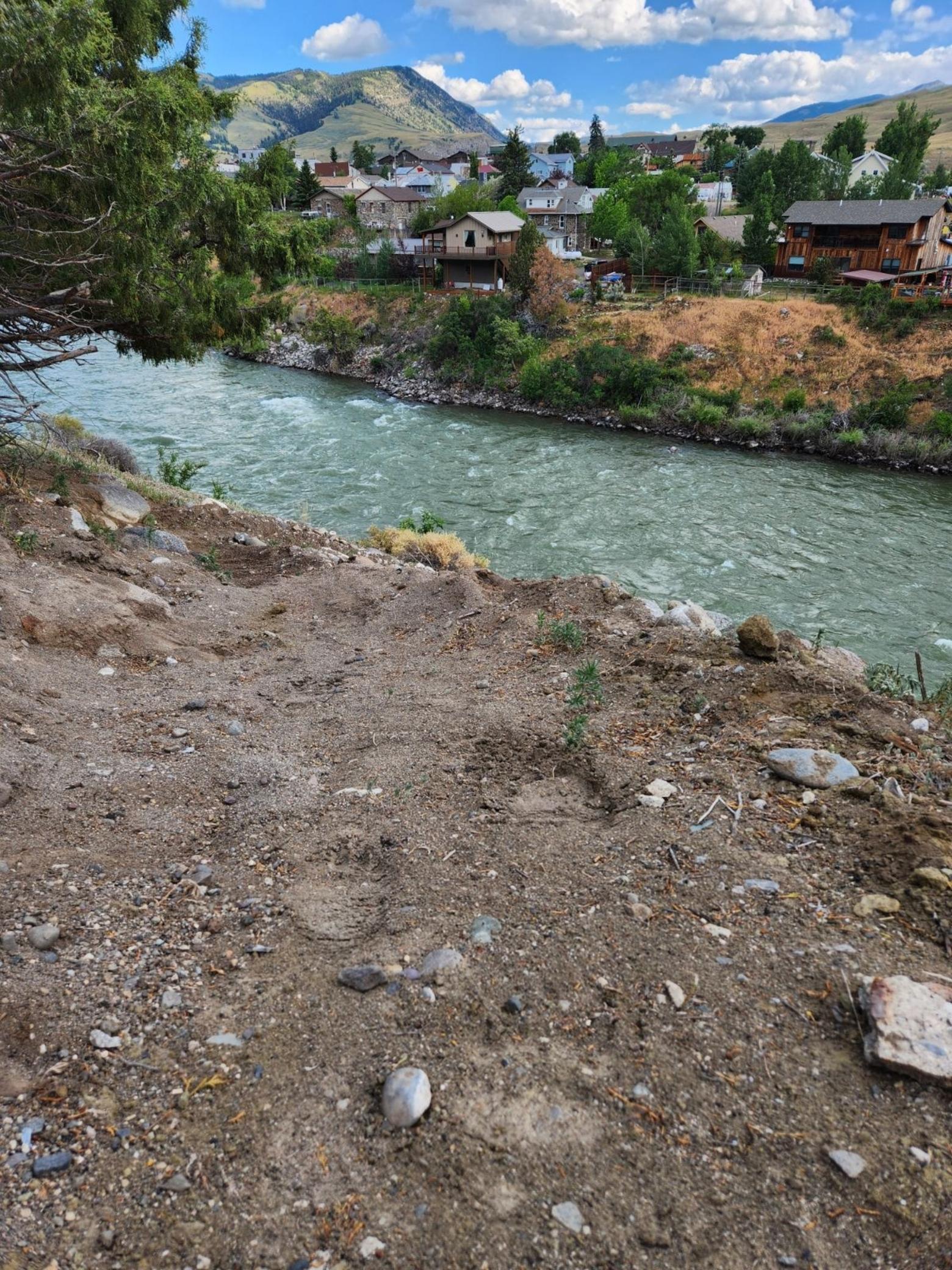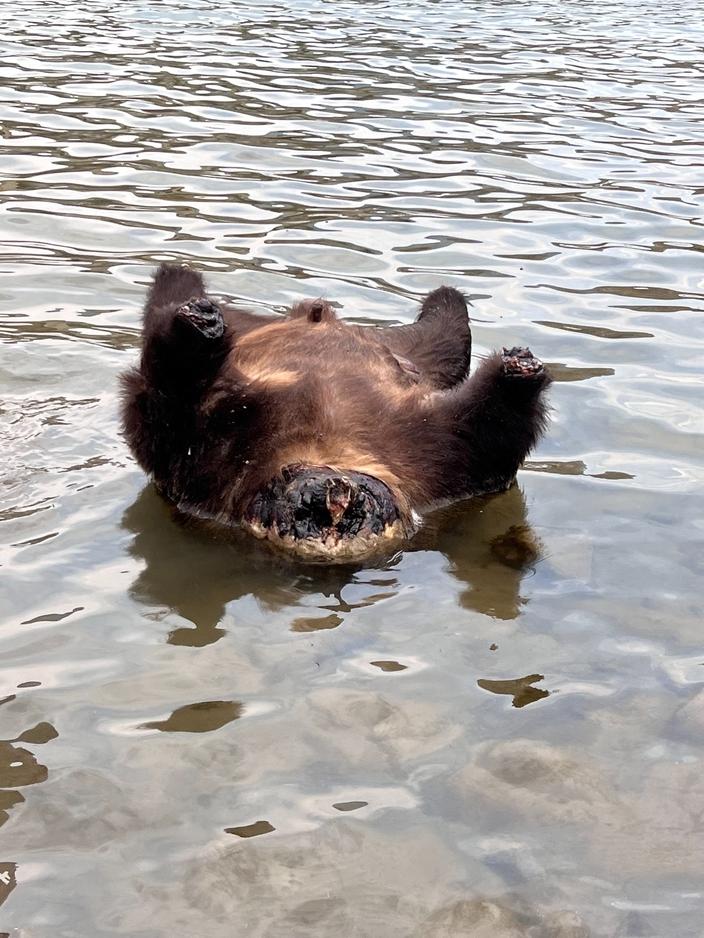Back to StoriesFood-Conditioned Grizzly Killed in Yellowstone River
August 2, 2024
Food-Conditioned Grizzly Killed in Yellowstone RiverFWP says it euthanized Grizzly 769, removed head and paws after multiple conflicts in Gardiner, Maiden Basin
by
Sophie Tsairis
Anglers on the
Yellowstone River in late July floated past an unusual and disturbing sight: a grizzly
carcass floating in the river, its head and paws missing. Montana Fish,
Wildlife and Parks confirmed the carcass had been a problem bear they had to
remove due to ongoing conflicts in the Gardiner area, north of Yellowstone
National Park.
In early June, FWP began receiving
reports of a male grizzly bear in Gardiner regularly seeking attractants at
homes and campgrounds. Incidents picked up toward the end of the month, when
the bear broke into homes in Gardiner, Maiden Basin, and a National Park Service
employee’s house in Mammoth.
Morgan Jacobsen, communications
and education manager for FWP, told Mountain Journal that they had staff in
Gardiner for several weeks—bear specialists and game wardens—who responded to
the conflicts, educated residents about the need to contain attractants, and
helped some neighborhoods upgrade their garbage cans and install electric
fencing.
“The outcome for this bear is unfortunate. If there's anything we can learn from all this, it's that there are things we can do as citizens and communities to avoid these conflicts from happening in the first place, like securing attractants in bear country." – Morgan Jacobsen, Communications and Education Manager, Montana FWP
Responding to conflicts
almost nightly, FWP attempted to capture the grizzly, to no avail, with culvert
traps, a common tactic in relocating bears. The traps include pipes welded onto
trailers with a sliding door on the back. The pipe is baited, the bear crawls
in to get the bait, and the sliding door closes behind it.
"The problem was that
while we worked to trap the bear, there continued to be other attractants
available in other locations," Jacobsen explained. "We couldn't
effectively entice the bear while there was so much else to choose from."
In the early morning of July
18, the bear, known as Grizzly 769, broke into a home in Maiden Basin. By the time FWP could respond
to the incident, it had crossed the highway and entered the Yellowstone River,
presenting an opportunity to euthanize the bear without endangering residents.
After FWP wardens shot the bear, it was carried downriver by the current, drifting
underwater and out of sight of FWP, which had employees in the river trying to
locate it.
Later that day, the carcass
washed up on the river's west bank, just north of Maiden Basin. "The
carcass was in a location where we could not safely and feasibly remove it from
the river," said Jacobsen. "It was in a spot with a vertical bank,
I'd guess 20-30 feet high, and we didn't have the personnel or equipment to
remove what was probably a 500-pound adult male grizzly."
The U.S. Fish and Wildlife
Service requires the removal of any body parts of potential monetary value when
disposing of threatened or endangered species. In compliance with this
regulation, FWP removed the bear's head and paws.
Jacobsen explained that this
is also the protocol if someone kills a grizzly in self-defense in the
backcountry. "It's the same procedure,” he said. “The carcass stays where
the bear dies, and we remove the head and paws. That way, the carcass can be
used by other creatures on the landscape. When we're able to capture a bear
before it is euthanized, they are removed using lethal drugs and, therefore,
cannot be left out on the land."
In a July 19 press release,
FWP noted that bear specialists had collected genetic samples at conflict
locations matching an adult male grizzly previously captured and tagged for
research purposes, confirming it as the same animal involved in the Gardiner
and Maiden Basin conflicts.
The bear carcass was visible
in the river for several days.
"It was very
noticeable, and understandably, people had mixed feelings about it," said
Jacobsen. “The outcome for this bear is unfortunate. If there's anything we can
learn from all this, it's that there are things we can do as citizens and
communities to avoid these conflicts from happening in the first place, like
securing attractants in bear country. Unfortunately, because the conflicts
continued and escalated, it created human safety risks that were not
acceptable."
Jacobsen said he witnessed
significant improvement in the community's ability to secure attractants during
this period.
"It does take effort,”
he said, “and sometimes it's an investment. Often we get caught up in the
business and routine of life and forget where we are: we're in southwestern
Montana; we have just about every kind of wildlife North America has to offer.
Living in a place like this comes with responsibility, a measure of obligation
to do our part to prevent conflicts from happening."
________________________________________________________________________________________________________________________
Mountain Journal is a nonprofit, public-interest journalism organization dedicated to covering the wildlife and wild lands of Greater Yellowstone. We take pride in our work, yet to keep bold, independent journalism free, we need your support. Please donate here. Thank you.
Related Stories
December 18, 2023
Guardrails on Growth in Paradise
As
land-use conflicts near a tipping point in Paradise Valley and surrounding locales, Park County Commissioners vote to
update the county's Growth Policy
...
February 20, 2024
As Wildfire Season Looms, Firefighters Battle Low Pay and Low Snow
The
Wildland Firefighter Paycheck Protection Act could permanently raise federal
firefighter salaries. But even if Congress can pass it, the proposed
legislation still isn’t...
April 4, 2025
Public Opinion Boils Over as Feds Continue Slashing Jobs, Budgets
Demonstrators attended more than 1,000 “Hands Off” protests across the nation and Greater Yellowstone.





